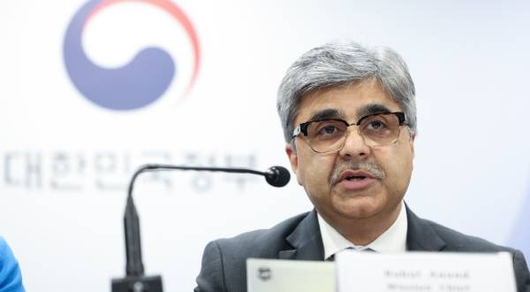 |
Rahul Anand, Chief of the Korea Mission at the International Monetary Fund (IMF), presents the results of the annual IMF-Korea consultation at the Government Complex Seoul on the morning of the 20th. (Yonhap) |
<이미지를 클릭하시면 크게 보실 수 있습니다> |
The South Korean economy is surrounded by multiple whammies, with the prolonged weak domestic demand and weak outlook. The stock market also remains sluggish and exports are threatened by heightened protectionist measures expected under the second Donald Trump administration.
The International Monetary Fund (IMF) recently downgraded Korea’s economic growth forecast to 2.2 percent for 2024 and 2 percent for 2025, citing weak domestic demand and uncertainties stemming from the Trump administration‘s trade policies.
Even exports, once a reliable growth engine, now face increasing risks due to weak performance in key industries amid rising global protectionism.
Companies struggle to grapple with the elevated pressure of high interest rates, soaring prices, and intensified competition from China.
POSCO shut down a steel mill and a wire rod mill, while Hyundai Steel Co. has suspended operations at one of its plants in Pohang.
The petrochemical sector, including Lotte Chemical Corp., suffered significant losses in the third quarter.
The government, however, is turning a blind eye to the worsening economic situation with a lack of urgency over the alarming signs.
In October, the Ministry of Economy and Finance said that “signs of recovery in domestic demand” were clear and that its policies helped boost economic vitality.
Such outright optimism leads to wrong diagnosis and wrong policy. Economic regulators must now focus on crafting immediate action and devising long-term strategies for economic restructuring based on precise analysis of the challenges.
이 기사의 카테고리는 언론사의 분류를 따릅니다.
기사가 속한 카테고리는 언론사가 분류합니다.
언론사는 한 기사를 두 개 이상의 카테고리로 분류할 수 있습니다.
언론사는 한 기사를 두 개 이상의 카테고리로 분류할 수 있습니다.


